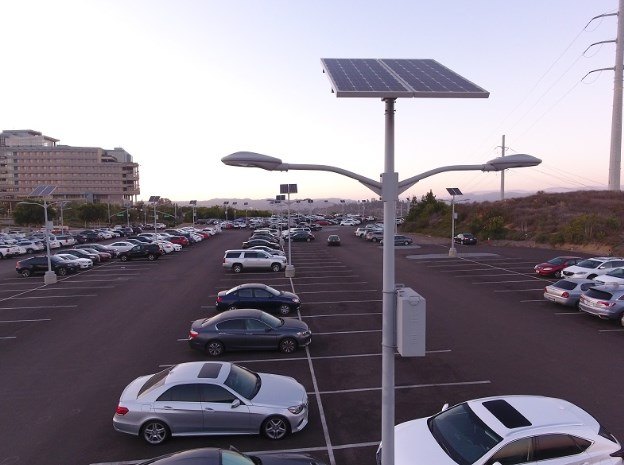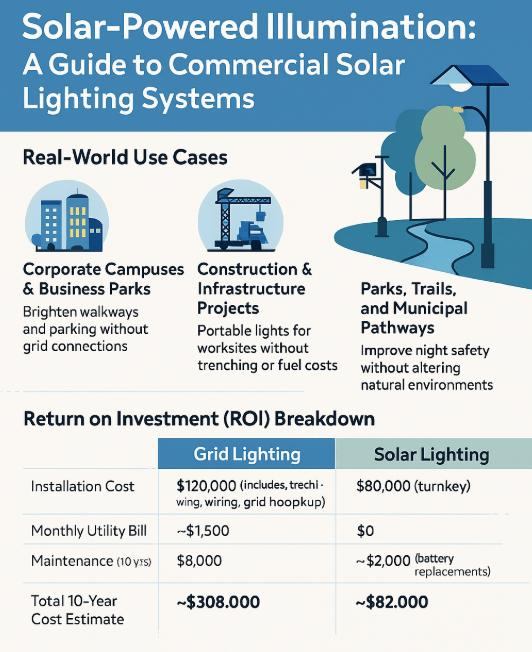Solar-Powered Illumination: A Guide to Commercial Solar Lighting SystemsPosted by Stephen Shickadance in Most Popular. Industry News. Solar FAQs.In a world that is increasingly embracing sustainable and eco-friendly practices, commercial solar lighting systems are emerging as an innovative and efficient way for businesses to light up their spaces while reducing their environmental footprint. These systems harness the power of the sun to provide reliable and cost-effective lighting solutions for various commercial applications. In this guide, we will explore the many benefits and components of commercial solar lighting systems, helping you make an informed decision for your business.
How Do They Work?Commercial solar lighting systems use photovoltaic (PV) panels to capture sunlight and convert it into electricity. This electricity is stored in batteries, allowing the lights to operate when the sun isn't shining, such as during the night or on overcast days. An intelligent control system ensures efficient energy management, turning the lights on and off automatically as needed. The Advantages of Commercial Solar Lighting Systems
|
| Metric | Grid Lighting | Solar Lighting (Greenshine) |
|---|---|---|
| Installation Cost | $120,000 (includes trenching, wiring, grid hookup) | $80,000 (turnkey) |
| Monthly Utility Bill | ~$1,500 | $0 |
| Maintenance (10 yrs) | $8,000 | ~$2,000 (battery replacements) |
| Total 10-Year Cost Estimate | ~$308,000 | ~$82,000 |
Payback period: typically within 3–5 years
Long-term savings: often 60–70% over 10 years
Battery Technology: More Reliable Than Ever
Today’s solar lighting systems use long-life lithium or deep-cycle lead-acid batteries, designed to store 3–5 days’ worth of energy—more than enough to handle cloudy weather or short winter days.
Key battery advantages:
Smart charging controllers prevent overcharging or power waste
Optional monitoring systems let users track battery health and usage remotely
Designed for 10+ years of service with minimal replacement needs
Smart Solar Integration: Lighting Gets Smarter
Commercial solar systems can now integrate with smart city and building systems:
Dimming controls save energy and reduce light pollution
Wireless monitoring allows teams to track lighting performance remotely
Zoning enables areas to be lit only when needed, improving efficiency
For municipalities or facility managers managing dozens (or hundreds) of lights, these features reduce O&M workload and provide better lighting control.
Industry Growth: Why Solar Lighting Demand is Surging
According to Allied Market Research, the global solar lighting market is expected to grow from $8.1 billion in 2023 to over $15 billion by 2030. Key drivers include:
Federal and state-level incentives for renewable projects
Rising cost of conventional electricity
Urbanization in developing and remote regions
Corporate sustainability targets (ESG compliance)
For Greenshine, this growth has translated into demand across industrial, retail, educational, and public sector markets—especially in areas with aging infrastructure or high energy costs.
Key Considerations for Installation
1. Location and Sunlight: Ensure that your location receives adequate sunlight to generate the necessary energy. Shading from trees or nearby buildings can impact performance.
2. Quality Components: Invest in high-quality solar panels, batteries, and LED lights to ensure long-term reliability and efficiency.
3. Maintenance Plan: Develop a regular maintenance schedule to keep the system in optimal condition.
4. Regulations and Permits: Check local regulations and obtain necessary permits before installation.
5. Design and Aesthetics: Consider the design and placement of the lighting fixtures to achieve both functional and aesthetic goals.
6. Cost Analysis: While commercial solar lighting systems offer long-term savings, perform a cost-benefit analysis to assess the initial investment against expected energy savings and environmental benefits.
Choosing the Right System
When considering a commercial solar lighting system, it's important to assess your specific needs and goals. Factors to consider include the location, desired lighting levels, and budget constraints. Working with a reputable solar lighting provider can help you design a system tailored to your requirements.
In conclusion, commercial solar lighting systems are a sustainable, cost-effective, and reliable solution for businesses looking to reduce their energy costs and environmental impact. By harnessing the power of the sun, you can illuminate your commercial spaces while contributing to a brighter and greener future. Make the switch to solar-powered illumination and join the growing movement toward sustainable business practices.
Archives
No Archives
Categories
Want More Info?
LATEST NEWS & ARTICLES


